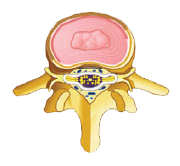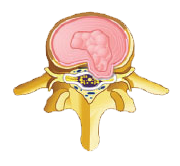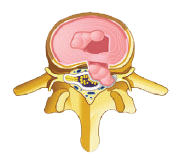Non-Surgical Lumbar Decompression
Non-surgical lumbar decompression – also referred to as spinal decompression – is a breakthrough technology that helps those suffering with back and leg pain due to disc ruptures, stenosis and arthritis. This FDA cleared procedure does not use drugs or surgery! Decompression works by use of a specialized table that creates somewhat of an anti-gravity environment in the spine that allows blood flow to penetrate the injured disc, allowing for the repair of damaged disc material. Since 2005 our office has consistently achieved an 80% success rate for patients we accept for treatment.
Non-surgical lumbar decompression can help you if you suffer from:
- Herniated lumbar disc
- Bulging lumbar disc
- Sciatica
- A relapse or failure following surgery
- Degenerative disc disease
- Spinal stenosis
- Facet syndrome


Relieving pain and healing discs:
As pressure begins to build inside the disc, it can cause a bulging of the inner material of the disc. Over time, as pressure continues to build, the disc may
rupture or herniate. This results in the material spilling out of the disc walls. When the material spills from the disc, it puts pressure on the nerves and other structures that cause pain. The resulting pain can travel down the legs, into the toes, or even the buttocks. It may also cause numbness in these regions and lead to dysfunction.
Our non-surgical lumbar decompression creates negative pressure within the disc by utilizing a special computer guided traction force. This negative pressure pulls the herniated material back into the disc and re-nourishes the disc. This breakthrough technology not only takes away the pain; it truly heals the disc (making it stronger than before) and restores disc height.

DISC DEGENERATION
The spinal discs receive nourishment through blood vessels until around 20 years of age. At this point, they have
been provided with a lifetime supply of nutrition. However, through normal wear and tear as well as aging, our
bodies use this nourishment and we experience a slow degeneration of the spinal discs. A fantastic benefit of decompression is that it heightens the disc space and is seen to return it to normal size and function.

DISC BULGE
The jelly-like nutritional substance in the center of the disc is prone to injury. The most common problems result from pressure placed on the disc. The pressure can cause the disc material to slip out of place, forming a bulge in the disc. This bulge then places pressure on surrounding structures, such as nerves.

DISC HERNIATION
When excessive pressure is placed on a bulging disc the disc may herniate, or rupture, through the outer wall of the disc. When the herniated material exits the disc, it can press on a portion of the nerves. As a result, the muscle involved may experience pain, radiation, and weakness. The nerve may also become “pinched”, which results in a condition known as sciatica. This condition causes a radiating pain to the buttocks and lower extremities.
